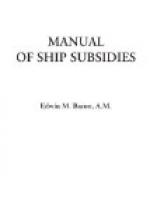In 1888, a new tariff of the previous year (July, 1887) having increased the customs duties on shipbuilding materials, additional bounties on construction and repair were granted by a royal decree to offset these disadvantages to the shipbuilders. A provision was added for the payment of fifty lire per gross ton for construction of war-ships, and eight and a half-lire per horsepower for engines, nine and a half lire per quintal for boilers, and eleven lire per quintal for other apparatus, to be used in war-ships. Navigation bounties were also added to Italian ships as follows: 0.65 lire per gross ton for every thousand sea miles run beyond the Suez Canal or the Strait of Gibraltar to or from ports outside of Europe; the same for ships sailing between one continent with its adjacent islands and another continent with its adjacent islands, outside the Mediterranean. Sailing-ships of above fifteen years of age were ineligible to these bounties; so also were mail-route steamers.[DS]
In 1896, after the expiration of this law, a new law was enacted (July 23) closely modelled upon it. The construction subsidies were the same, except that war-ships built for foreign countries were debarred from receiving bounties. The navigation subsidy per gross ton for every thousand sea miles sailed beyond the Suez Canal and the Strait of Gibraltar was increased to 0.80 lire, the rate to be diminished by ten centimes for steamers and fifteen centimes for sailing-ships every three years. An important addition was the reenactment of the customs rebates on shipbuilding materials. This law was also to be in force ten years.[DS]
In 1900 (November 16) a royal decree was issued modifying the law of 1896 in several particulars. No bounty was hereafter to be allowed to vessels built in Italian yards for foreigners. The customs drawbacks were abrogated, and in place of them was granted a bounty of five lire per quintal of metal used in repairs. A bounty of fifty-five lire per gross ton was offered for iron or steel steamers showing a speed of above fifteen knots; fifty lire, for steamers speeding twelve to fifteen knots; forty-five lire, for steamers or sailing-ships with speed below twelve knots; and thirteen lire per net ton for modern hulls. The navigation subsidies per gross ton per thousand miles, were thus fixed: for steamers, forty centimes up to the fifteenth year after construction; for sailing-ships, twenty centimes up to the twenty-first year after construction. The yearly distances run for which the bounties were to be paid were limited to thirty-two thousand miles for a steamer below twelve knots; forty thousand for one of twelve to fifteen knots; fifty thousand above fifteen knots, and ten thousand for a sailing-ship. All Italian ships were eligible to this bounty; foreign ships were debarred. The maximum expenditure for all the bounties was limited to ten million lire ($2,000,000) a year.




